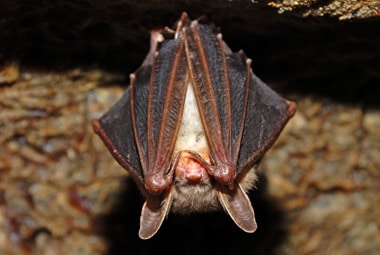
Bats have a bad rap. They are not in any way a flying rodent, nor do they want to suck your blood, nor will they magically turn into a vampire. They are actually a mammal with all the common traits of one, except that they are the only mammal naturally capable of true and sustaining flight. There are thousands of types of bats worldwide. Their numbers are so immense that they take up nearly a quarter of the mammal population. They are the second largest order of mammals, second only to rodents. Missouri is home to 14 kinds of bats.
| Pest Identification | |
|---|---|
| Recognition | Being a mammal, bats are clean, shy and intelligent. They are found in almost every worldwide habitat. Classified in the Chiroptera family, which explains their appearance, “Chiro” meaning hand, and “pteron” meaning wing. Their wings are not actually wings. The number and arrangement of bones in a bats ‘wings’ are the same as those of a human arm and hand, except that their ‘finger bones’ are greatly elongated and connected with a double membrane of skin that forms the ‘wing’. Bats are divided into two suborders: megabats and echolocating microbats. Megabats are mostly fruit-eating bats and tend to be the larger of the two suborders. Megabats are usually found in tropical and subtropical areas. They do not use echolocating, but rely heavily on their keen sense of sight and smell to navigate and located food. They are strictly vegetarian. These amazing creatures range anywhere from 2.4 inches up to a wingspan of 5.6 feet. Echolocating microbats use echolocating, or bio sonar to locate and identify objects. Basically, they emit calls out to the environment and then listen to the echoes of the calls to located things around them. Microbats feed mostly on insects, although, some of the larger species of microbats hunt birds, frogs, lizards and fish. Their size ranges anywhere from 4 to 16 centimeters long. |
| Biology | Being a mammal, bats give birth to live young (pup). Here in Missouri, most bats breed in autumn and the female’s store the male’s sperm throughout her winter hibernation and fertilization takes place the following spring. She is only pregnant for a few weeks before her ‘pup’ is born. Most female bats only produce one offspring. There are a few species that give birth to multiple pups, but this is not usually the case. Pups are born at about half their adult body weight. The pup will feed off the mother’s milk until they are capable of getting their own food. Within two to five weeks, these quick growing mammals are usually able to fly on their own. |
| Habits | Here in Missouri, the winter is too cold for the bats to get enough insects to sustain their existence, so they enter into a winter hibernation or they migrate to warmer climates. A hibernating bat can survive on a teeny amount of stored body fat over the five to six month hibernation period. They commonly loose one-fourth to one-half their total body weight over their hibernation. Each time that a bat is awakened during its winter slumber, it may lose up to two months of stored fat reserves for hibernation just by awakening its body. If it is repeatedly disturbed than it must emerge early from hibernation in search of food. Unfortunately if it is still too cold for insects to be readily available, then it will starve. This is why it is very important to not disturb a hibernating bat. Upon waking from their winter slumber, bats will emerge hungry and begin searching for food. Bats help control nocturnal Missouri insects, some of which are agricultural pests, or annoying and dangerous to people, like mosquitoes. Bats hang upside-down at rest to utilize gravity to gain enough speed to begin to fly. They can simple let go, pick up speed by falling and then flap their wings to fly. Bats eat by capturing insects with their mouths or scooping them into their wing or tail membranes. After capturing the insect, they reach down and take it into their mouth. This method of eating and hunting is what causes the swooping and darting motions in their flying that we are all accustomed to seeing at night. They hunt near street lights and outdoor lighting because of the amount of insects that are drawn to the lights. |
| Prevention | Bats are a great benefit to our natural environment, but they are not beneficial inside our homes or buildings. Here are some suggestions for keeping bats out of your home or building: -Seal any exterior holes or cracks that may allow bats entry, this includes plumbing and utility entrances -Repair or replace door, window and ventilation screens that are damaged -Use proper chimney caps to keep bats out |
| Professional | Bats are protected, just like any other wildlife. Do NOT try to handle them on your own. If you have a problem with bats that are in your home, or you feel that there may be a chance that you will, taking preventative steps will certainly help, but a dual approach to preventing and ridding yourself of bats and future bats is the best and most complete way to go. Here at Rottler Pest we have specially trained wildlife removal specialists. Our wildlife services include: -Inspection: to find and locate all affected areas of the infestation. -Removal: properly, and humanely trap and remove the unwelcome wildlife -Return & Inspection: to re-inspect that all is done correctly and the animal has not been able to return. We stand behind our wildlife service for one year, and will return to you within that year if the problem reoccurs. -Damage Repair & Exclusion: Clean-up of any mess (droppings, stored food, nests, etc.) left behind by the wildlife and seal up all possible entrances to ensure that re-entry is impossible. (Additional charges may apply) |

